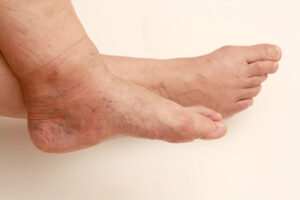What is the treatment for varicose veins?

If you’ve got varicose veins, you may be reluctant to seek treatment. In the past, varicose veins required surgery, complete with a hospital stay and a long recovery. Here’s the good news: today, treatment for varicose veins is much less invasive than that.
Varicose veins are caused by blood flowing the wrong way, due to faulty valves inside the veins. While this problem cannot actually be rectified, treatments can alleviate the discomfort of varicose veins and improve the aesthetics. There are some things you can do at home to treat varicose veins, but medical intervention will be focused on destructive intervention, eliminating the damaged vein.
- Home treatment is typically the first course of action. Your doctor may suggest compression stockings to put pressure on the veins and prevent blood from pooling. Elevation is another approach, propping the legs above the waist several times a day to increase circulation. Improving your diet and increasing your exercise can also help.
- Laser therapy is a viable treatment option for varicose veins. In a process called endovenous laser ablation, the doctor collapses, closes, and cauterizes the varicose vein. The body then compensates by rerouting the blood into a healthier vessel. For spider veins, a laser can be used outside of the skin.
- Radiofrequency treatment works similarly to laser therapy. Radiofrequency energy is used to close off the vein. This type of treatment works well for large varicose veins in the legs.
- Sclerotherapy uses an injection to close the vein. By injecting a chemical into the varicose vein, the doctor damages and scars it, causing it to close. This is best used on small veins.
- Microphlebectomy removes the vein. It’s done through two very small incisions, though, and doesn’t require a hospital stay or a lengthy recovery period. Rather, it’s performed in the doctor’s office and the patient can typically resume regular activity immediately.
- Vein surgery isn’t used as much as it once was. It used to be the standard for care, but now that there are less invasive procedures available, it’s fallen out of favor. Vein surgery involves a process called ligation and stripping, in which the surgeon ties off the vein to stop blood from pooling in it, then removes it to prevent the reappearance of varicose veins.
With so many options for varicose vein treatment, it’s important to take the time for a thorough examination and treatment plan from a vein specialist. The right doctor will know exactly how to advise you and which treatment is right for you. If you’re looking for the very best care for your vein and blood flow issues, trust the board-certified physicians at the Arizona Vein & Laser Institute. Using the most advanced technology, the vascular and cardiovascular surgeons at the Arizona Vein & Laser Institute provide care for all types of venous diseases. With over 40 years of experience, our team of experienced physicians can devise the right treatment plan to address your venous disease problems. For more information contact us through our website.
